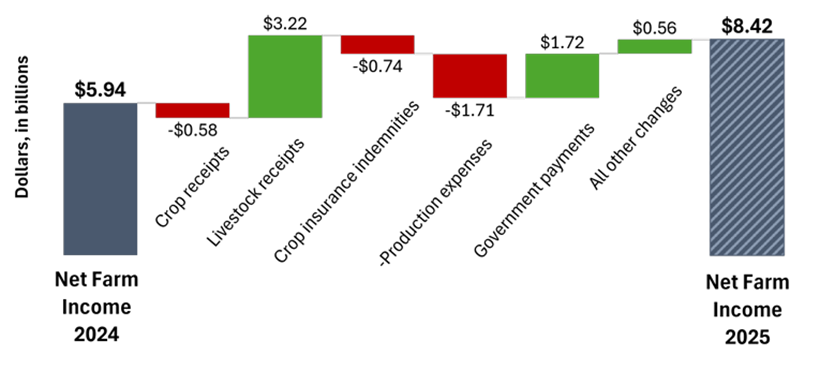A Tale of Two Sectors


“Patience is a virtue” is a well-known proverb. Tidbits, with little patience, jumped the gun last week when it discussed Nebraska net farm income in 2024. If Tidbits had been patient, and waited one more week, the latest forecasts for 2025 and 2026 which came out last week could have been included in the discussion. So, at the risk of being repetitive, net farm income is a topic for the second consecutive week. It’s hard to be virtuous.
Brad Lubben, an agricultural policy specialist at the University of Nebraska, describes current income conditions in agriculture as a tale of two sectors. “The aggregate outlook for increased farm income in 2025 really hides a divide between ag sectors. Beyond higher government payments, livestock receipts are climbing on stronger cattle prices while crop receipts continue to decline with lower corn and soybean prices. The result is a farm economy that looks stronger on paper than many producers may feel in their day-to-day operations.” Lubben’s comments were directed at the latest projections pegging Nebraska net farm income at $8.42 billion this year, $2.48 billion or 42% higher than 2024. The projections come from the Rural and Farm Finance Policy Analysis Center at the University of Missouri in collaboration with the Center for Agricultural Profitability at the University of Nebraska.
Figure 1 shows a “waterfall” chart outlining farm income components. Income for 2024, $5.94 billion, is on the left and projected changes to the components between 2024 and 2025 are shown moving across the chart to the right culminating with this year’s projected income. Farm receipts are expected to increase $1.85 billion this year with livestock and government receipts being the primary reasons. Livestock receipts are projected $3.22 billion higher, mostly due to higher cattle receipts, up $3.05 billion due to higher cattle prices. Also, government payments are projected to be $2.22 billion, a substantial increase over 2024. These increases offset a decline in crop receipts of $.58 billion due to lower prices. Corn receipts are projected to fall 3% while soybean receipts are expected to decline 7%.
Expenses are projected to rise $1.72 billion this year to a record $30.39 billion. The growth is fueled by expenses for purchased livestock, up 24% to a record $11.12 billion. Expenses for fertilizer and soil amendments are also expected to increase, but feed costs, net rent to landlords, fuels, and interest costs are expected to decline.
FIGURE 1. Changes in Net Farm Income

If realized, the projected farm income would be the second highest on record in nominal terms and the fifth highest in real terms. More of the same is expected in 2026 where net farm income is projected to be $8.37 billion. Crop and livestock receipts are projected higher, production expenses stable, and direct government assistance is expected to decline.
“May you live in interesting times” is another well-known proverb. The current times are certainly interesting given the unprecedented uncertainty which exists. Projecting the future, never an easy task, is more fraught when uncertainty is high. Changing tariffs, trade deals, interest rates, input costs, government assistance, and other factors will affect future farm economic outcomes. However, the latest projections provide insights into the financial state of Nebraska agriculture. More information on the projections can be found at: https://cap.unl.edu/farm-income.

